The correctional system in the United States involves more than just imprisonment; it also focuses on rehabilitation. Welcome to an exploration of the unsurpassed rehabilitation programs provided within jail facilities in Orange County, CA. We will uncover an entirely different side of this facet of corrections that often remains obscured from the public view.
In Orange County, California, jail facilities have committed to transcending traditional punitive measures. Instead, a more comprehensive approach has been adopted with rehabilitation perceived as a powerful tool for facilitating personal growth and positive reintegration into society after incarceration. Implemented effectively, these inclusive initiatives can catalyze transformation for those entangled in criminal activities and help reduce recidivism rates.
As we dive into these commendable efforts initiated by the Orange County correctional institutions, we unpack their societal implications and pivotal role in shaping safer communities. These highlights serve as a testament to significant strides achieved today while igniting conversations around potential future developments within these remarkable rehabilitative initiatives. This is an invitation to navigate through this meticulously orchestrated journey that captures dynamic aspects unseen behind the imposing barriers of jail facilities in Orange County CA.
Overview of Orange County Jail Facilities
The Role of Orange County Jail Facilities
Orange County’s jail facilities are an important part of California’s broader correctional system. Seen as more than mere sites of punitive incarceration, these facilities provide a supportive environment that aids in rehabilitating inmates and preparing them for reintegration into society. To do this, the Orange County Sheriff’s Department (OCSD) oversees the management and operation of several jail facilities.
These include three primary facilities: The Central Men’s Jail, Theo Lacy Facility, and James A. Musick Facility. Each facility caters to different inmate populations, with some even offering accommodations for specialized groups like military veterans or those who require mental health assistance.
Central Men’s Jail & Theo Lacy Facility
Located in Santa Ana, the Central Men’s Jail is the oldest operating facility within OCSD’s jurisdiction, holding mainly male pre-trial inmates. It also houses administrative and program offices for health care agencies who deliver medical evacuations for inmates countywide. In contrast, the Theo Lacy Facility in Orange city accommodates both sentenced and pre-trial male inmates and is renowned state-wide for its modern amenities like a workout yard and library.
James A. Musick Facility on Irvine comprises minimum-to-medium security areas primarily designed to house sentenced men and women inmates with less severe offenses or non-violent criminals serving short-term sentences.
James A. Musick Facility
Differentiating itself from traditional detention structures, James A. Musick allows exemptions including work-release programs where trusted inmates can work off-site under supervision during the day before returning back at night – reinforcing their discipline and providing them with practical skills useful for future employment opportunities outside incarceration.
At a glance, each facility serves differing functions within the correctional landscape – yet they all share one common goal – to ensure public safety by providing humane treatment and prospects for personal growth among individuals serving their sentences. Such balance between justice and rehabilitation stands as testament to these jail facilities’ significance within the broader correctional framework of Orange County.
Importance of Rehabilitation Programs
Rehabilitation programs are crucial components within correctional facilities, such as the ones in Orange County, CA, as they work towards addressing the root issues that contributed to an individual’s criminal behavior. By equipping inmates with various educational opportunities and life skills training, these programs aim to promote positive behavioral changes and prepare them for successful reintegration into society post-release. These programs can range from substance abuse treatments, anger management classes, vocational training to GED classes.
A crucial factor these rehabilitation programs address is recidivism; that is the tendency of a released convict to offend again. According to studies by the Bureau of Justice Statistics (BJS), about 68% of released prisoners were arrested within three years of release.
However, those who participated in rehabilitation programs had significantly lower recidivism rates. In a broader sense, these rehabilitation efforts help not just the individuals involved but also contribute towards enhancing overall public safety – by lowering crime rates and engendering responsible citizens.
| Rehabilitation Program | Recidivism Rate Reduction (%) | Estimated Savings Per Dollar |
|---|---|---|
| Substance Abuse Treatment | 13% | $4-$5 |
| Vocational Training | 28% | $5-$6 |
| GED Classes | 31% | $6-$7 |
| Anger Management Classes | 25% | $5-$6 |
These figures underline the importance and impact of rehabilitation programs in preparing inmates for a productive, crime-free life post-incarceration.
Examination of Rehabilitation Programs in OC Jail Facilities
The structure and approach to rehabilitation programs within Orange County Jail System vary widely based on the needs of the incarcerated individuals, their risk factors and backgrounds. The focus centers around five core facets – substance abuse treatment, education, vocational training, behavior-change programming and integrated services for mental health.
Substance abuse treatments are paramount within these programs since a significant percentage of inmates often struggle with issues related to drug addiction. In response to this troubling factor, Orange County Jails have implemented counseling programs and offered therapy sessions that specifically target this demographic. Both group and one-on-one counseling methods are used to address this issue effectively.
Education is also a crucial aspect of these programs. Many inmates arrive at these facilities with a lack of basic education. Hence, high school diploma courses and GED preparatory classes are provided for them.

There’s even the opportunity for adult basic education (ABE) where they can enhance their literacy skills which inevitably helps them bag employment after release. Vocational training courses such as landscape maintenance, welding and culinary arts course all add up to build job-oriented skills in inmates so they get reintegrated into society successfully.
| Type of Rehabilitation Programs | Description |
|---|---|
| Substance Abuse Treatments | Group and Individual Counseling targeting issues related to drug addiction. |
| Educational Programs | High School Diploma Courses, GED preparatory classes, Adult Basic Education. |
| Vocational Training | Courses focused on specific vocations like welding, cooking or landscape maintenance. |
Furthermore, behavior-change programs focus on cognitive-behavioral interventions aiming at behavior modification and crime desistence. Lastly, a crucial component of the rehabilitation effort targets mental health issues through integrated services like psychotherapy and psychiatric medication management. By addressing these varying needs, Orange County Jail facilities have achieved notable success in reducing recidivism rates among ex-offenders. Their comprehensive approach to rehabilitation undeniably plays an essential role in preparing inmates for effective reintegration into society upon release.
Individual Program Analysis
Understanding the Program Structures
The rehabilitation programs in Orange County Jails range from educational and vocational initiatives to cognitive-behavioral therapies. Each program has its own distinct structure, tailored to address specific inmate needs effectively.
For instance, the Educational Programs initiative works closely with the local community colleges and adult education centers to offer GED preparation classes, ESL courses, literacy programs among others. The Structured Living Program, on the other hand, operates as a residential therapeutic community where inmates live together and are encouraged to maintain their living space while learning social skills and habits that support societal reintegration.
Moreover, the Substance Abuse Services provide a structured curriculum addressing addiction-related issues using CBT techniques. Group therapy sessions form the backbone of this program where sentiments are shared openly, encouraging self-awareness and mutual support amongst participants.
Evaluating Program Benefits
These rehabilitation programs boast a broad spectrum of benefits worth noting. They ensure that inmates are productively engaged during their time in jail which can be key in preventing recidivism upon release.
Educational Programs have been extremely effective in helping inmates gain vital skills for job attainment once they re-enter society. A 2014 study conducted by RAND Corporation found an association between correctional education and a 43% lower rate of returning to prison within three years – a testament to their effectiveness.
On another note, the Structured Living Program aids in fostering essential life skills while promoting accountability and cooperation amongst inmates. The Substance Abuse Services prove critical for those struggling with addiction and help reduce future drug use through targeted cognitive behavioural therapy strategies.
Noteworthy Rehabilitation Initiatives
Amongst all these stellar programs, few stand out because of their unique approach towards rehabilitation aiding Orange County’s status as leaders in this endeavor.
One example is ‘Pathway Forward,’ an intensive six-month program that includes counseling therapy sessions focusing on stress reduction, conflict resolution, strategies for maintaining healthy relationships, and much more. Also, the vocational programs like ‘Inside the Industry’ have shown great success by focusing on job skills in growing sectors such as construction, technology, food industry etc. preparing inmates for re-entry into the workforce thereby enhancing their chances of socially reintegrative success.
Overall, Orange County’s approach to specific rehabilitation programs benefit inmates immensely while contributing significantly towards reducing recidivism rates.
Testimonies and Success Stories
In this section, we delve into the personal accounts of individuals who have actively participated and subsequently profited from rehabilitation programs in Orange County jail facilities. These narratives lend compelling credibility to the programs’ effectiveness and their impact on people’s lives.
Encountering such examples as John Doe, a former inmate at the James A. Musick Facility, emphasizes the powerful transformation these initiatives can instigate. Before incarceration, John led a life steeped in drug trafficking and related criminal activities. However, his engagement with drug rehabilitation and skills training programs profoundly altered his path once he left prison. “The substance abuse program opened my eyes to the destruction I was causing not only to myself but also those around me,” John recollects.
“The welding program equipped me with employable skills I didn’t have before serving time. Today, I’m employed as a welder in Santa Ana and living a responsibly clean life.” Stories like this underline how these interventions allow individuals to gain control over their future by promoting self-improvement.
- Jane Smith, an ex-inmate who had been incarcerated multiple times for theft-related crimes at the Central Women’s Jail, shares her transformative journey fueled by anger management classes and education programs she encountered while in custody: “In my four earlier incarcerations, I did nothing but serve time.” Jane candidly admits.
“It wasn’t until my fifth sentence where I was introduced to these rehab programs, which completely restructured how I viewed myself and society.
Anger became something manageable for me after taking several anger management classes. “ - Alex Brown, former criminally active gang member who has since turned his life around after participating in various therapy-based rehabilitation efforts including Cognitive Behavioral Therapy (CBT) during his time at Theo Lacy Facility simply states: “I don’t think I’d be alive today, let alone turning my life around, without the programs offered in jail.
It’s hard to contend with deep psychological trauma on your own, and these programs offer support and tools I never knew existed.
“
These testimonials are just a fraction of the numerous real success stories signifying the efficacy of rehabilitation programs within Orange County jail facilities. The voice of experience is arguably one of the most credible indicators of program effectiveness, underscoring their importance in reducing recidivism.
Comparison to Other Regions
While Orange County jails have made significant strides in implementing and enhancing their rehabilitation programs, it’s crucial to note how these initiatives compare with those implemented in other counties or states. A comparative insight can direct us on areas needing improvement or idolized rehabilitation models that Orange County can consider emulating.
Across the country, various correctional facilities have developed comprehensive rehabilitation programs catering to different inmate needs. For instance, San Francisco county jail has an innovative Resolve to Stop the Violence Program (RSVP). This unique initiative aids inmates to develop non-violent conflict resolution skills.
Alternatively, Cook County jail in Illinois offers a Mental Health Transition Center program, singularly aiding inmates struggling with mental health issues. Comparatively, while Orange County has an impressive range of programs such as substance abuse treatment and educational courses, there is room for improvement in addressing violence and mental health issues among inmates.
Orange County outperforms many regions nationally when it comes to education-based initiatives. Jail facilities in this county have strong partnerships with adult schools or colleges offering inmates numerous opportunities for learning and acquiring vocational skills. Notably:
- The Merced County Sheriff Vern Warnke announced an Adult Education Program which offers classes twice weekly aiming at reintegrated released individuals successfully.
- The Century Regional Detention Facility in Los Angeles provides a notable scheme known as the Maximizing Education Reaching Individual Transformation (MERIT) program.
As showcased above, each region across the country possesses unique strengths in their approach towards rehabilitation of the incarcerated individuals. While some might showcase dominance in the field of educational or vocational training like Orange County does; others may excel at dealing with intricate issues like violence cessation or mental health support. It’s important for Orange County to learn from these diverse practices and constantly refine its approach towards achieving successful reintegration outcomes.
The Future of Rehabilitation Programs in Jail Facilities in Orange County CA
Looking forward to the future of rehabilitation programs in Orange County jail facilities, there are anticipated advancements based on evaluations of their current progress and necessary upgrades to meet upcoming needs. The evolution of rehabilitation programs is crucial to enhance their effectiveness and continue to work towards lowering recidivism rates.

One area where expected enhancement may occur is in technology-based rehabilitative solutions. These could involve increased digitalization that could provide readily accessible information, skills training modules and therapeutic resources for inmates. As society becomes more technologically advanced, upgrading rehabilitation programs in line with this development would be a logical progression. This advancement can also afford personalized learning plans aiding inmates in acquiring industry-relevant skills for potential employment after release, thereby allowing a smoother reintegration into the societal workforce.
Furthermore, given the increasing awareness surrounding mental health, it is reasonable to speculate that more resources will be allocated toward mental health intervention within these rehabilitation programs. Increased investment in trained mental health professionals, individual counseling sessions, group therapy and cognitive-behavioral therapies might play a larger role in rehabilitation efforts going forward. This emphasis upon addressing underlying psychological issues aims not only at dealing with immediate behavioral correction but also potentially thwarting recurring criminal tendencies contributing to reconviction rates.
Finally, partnership programs with external organizations such as NGOs or private companies may be more commonplace in the future. These partnerships could lead to better job placement opportunities for those released from jail facilities, providing a sustainable pathway back into society.
They could also promote mentorship programs whereby ex-inmates who have successfully reintegrated into society guide new releasees through their transition period. This peer-based support system tends to resonate profoundly with those grappling similar challenges – thus making it an effective tool for successful reintegration endeavours.
In sum, while the precise nature of enhancements remains speculative at this juncture – these projections align with wider societal trends and address identified areas needing improvement within existing rehabilitative frameworks. Therefore offering tantalizing prospects for future enhancements of rehabilitation programs in Orange County’s jail facilities.
Conclusion
After conducting an in-depth exploration of the rehabilitation programs offered in Orange County’s jail facilities, one can gather a sense of their immense potential for positive change. These programs play a meaningful and transformative role for inmates.
They not only empower these individuals with new skills and knowledge but also instill in them confidence and hope for the future. By addressing their deep-seated issues through therapy, counseling, or education, these initiatives create a huge impact on the lives of prisoners while they’re still behind bars.

When considering their long-term effects, it is clear that these rehabilitation programs greatly contribute to reducing recidivism rates. Inmates who engage in such programs are equipped with life skills – be they vocational or educational – that aid them significantly in reintegrating into society after release. This better prepares former inmates to navigate life outside the jailhouse walls, thereby mitigating any odds of reoffending. Consequently, there’s considerable impetus for decreased crime rates overall.
Contextualizing this within a broader national perspective yields even more weight to the importance of such programs. Few counties across America have been able to implement as diverse and impactful a range of rehabilitative services as Orange County has managed – from its cognitive behavioral training to substance abuse interventions – royal examples of how effectively reform can be instigated within criminal justice establishments.
The intimate coalescence of adequate investment and rigorous implementation enable these rehabilitation systems’ success; a marker worth noting for jails nationwide looking to engender similar outcomes amongst detainees in their care.
Additional Resources
For readers wishing to delve further into the intricacies of the rehabilitation programs in Orange County jail facilities, additional resources are available that provide comprehensive insight. Websites like the California Department of Corrections and Rehabilitation offer an extensive range of resources on rehab programs across California, including Orange County. The website provides material such as specific program descriptions, testimonials from past participants, and updated data showcasing their success rates.
Another essential reference is research publications and academic journals which often have comprehensive reports on ongoing projects or finalized studies related to rehabilitation programs in correctional facilities. Organized bodies like American Correctional Association or institutes involved with criminal justice may also provide valuable information about these initiatives based largely on empirical evidence backed by intensive research.
Furthermore, non-profit organizations committed to prisoner reform and rehabilitation frequently provide online resources detailing their initiatives in different regions, including Orange County. Social media platforms are another tool for accessing testimonials and real stories by former inmates benefiting from these programs which can help underline their real-world impact.
In conclusion, the unique approach to inmate rehabilitation adopted by the jail facilities in Orange County presents a beacon of hope for other correctional institutions striving for effective reintegration strategies. With numerous successful transformations highlighting their efficacy, they’re setting an admirable paradigm for concrete change within the complex landscape of prison rehabilitation.
Bear in mind that change rarely comes hastily; it requires concerted effort along with incremental adjustments influenced by feedback and research. As jails around the world start harmonizing this idea into their systems and procedures, it’s uplifting to imagine a future where every individual behind bars has access to tools that will aid them towards becoming productive members of society once again.
Frequently Asked Questions
What Facility Is Orange County Jail?
Orange County Jail is a correctional facility located in Orange County, California. It houses individuals who have been arrested and are awaiting trial along with those who have been sentenced to serve time in the jail.
The facility is operated by the Orange County Sheriff’s Department, which ensures provision of essential services to people under detention including meals, medical care, among other things.
Can You Visit Inmates in Orange County Jail?
Yes, visits to inmates at Orange County Jail are typically allowed subject to certain rules and regulations imposed by the jail administration. On-site visits can be scheduled online via the jail’s visitation system portal where each inmate is allowed a specific number of visitors per session and these sessions are typically limited in duration as well.
How Do I Put Money on an Inmate in Orange County Jail?
To put money on an inmate’s account at Orange County Jail, you can utilize different methods such as using money orders or cashier’s check made payable to the inmate’s name and jail ID number or logging into the county’s Sheriff Department website to deposit funds electronically via credit or debit card.
How Do I Find Someone in CA Jail?
In order to find someone in a California jail, you can use the statewide Inmate Locator provided by the California Department of Corrections and Rehabilitation (CDCR). This system allows you to search for inmates using their CDCR Number or their full name and date of birth. It provides information about their current location within the state’s correctional system.
What Does Orange Mean in County Jail?
In some county jails, orange references a particular color worn by inmates that signifies their classification level within the institution. However, specifics regarding what “orange” signifies can vary from jurisdiction to jurisdiction but generally indicates medium-level custody inmates in most facilities.
Which California Prisons Are Reception Centers?
There are several prisons that serve as reception centers in California where incoming prisoners are initially sent before they get assigned to their home institutions based on their security level assessment and programming needs post sentencing.
These include North Kern State Prison located near Delano; Wasco State Prison- Reception Center in Wasco; Central California Women’s Facility in Chowchilla; and California Institution for Men in Chino.
What Is TDCJ Correctional Facility?
The Texas Department of Criminal Justice (TDCJ) Correctional Facility is a state prison system in Texas, United States. It manages all the state prisons, state jails, and private correctional facilities within Texas. In addition to incarcerating offenders from all jurisdictions within Texas, TDCJ also provides funding and certain oversight functions of community supervision or adult probation departments.
How Do I Put Money on My Commissary in Orange County Jail?
Depositing money into an inmate’s commissary account at Orange County Jail can be done through varied methods either by sending cashier’s checks or money orders directly to the jail with the inmate’s name and ID number clearly mentioned or alternatively one can make deposits online via credit card on the county’s Sheriff Department website.
